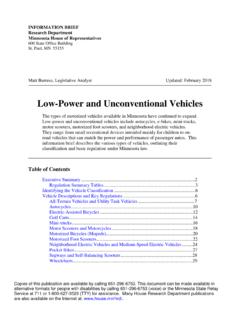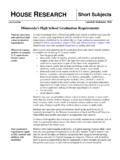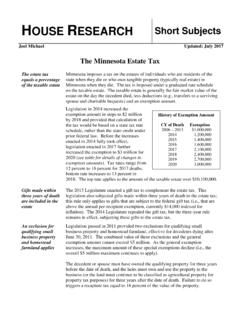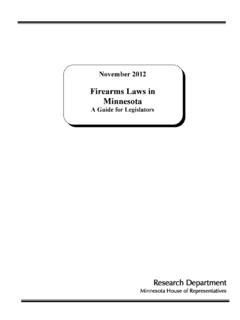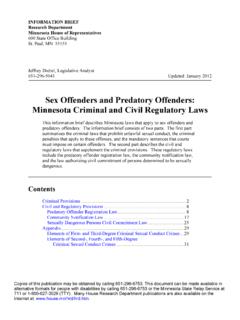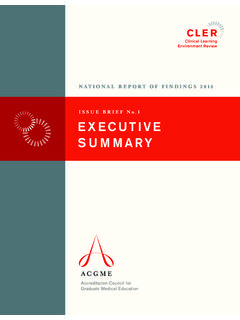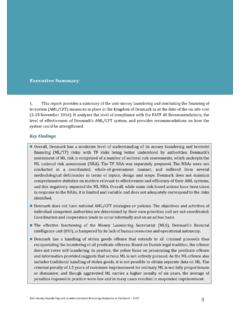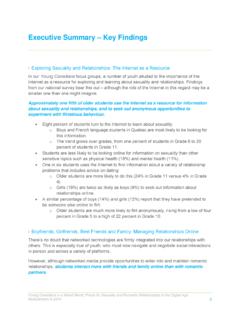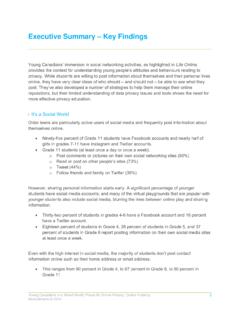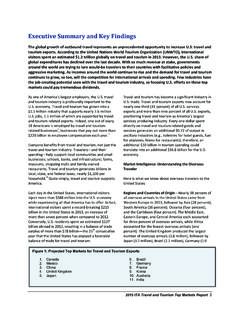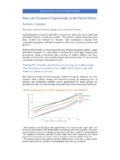Transcription of 1 Executive Summary and Key Findings
1 1 Executive Summary and Key Findings Similar to state governments across the nation, Minnesota s state employees are older than non-government employees and large numbers will be eligible to retire very soon. State government workforces, including Minnesota s, are aging faster than federal and local governments. Financial pressures posed by Minnesota s state budget point toward a workforce reduction, which in turn poses important considerations for workforce planning and development. In 2000 the median age of state employees was In 2010 median age for state employees has increased to In fiscal year 2010, within the Executive branch of state government, the average retirement age was There were fewer retirements than average in fiscal year 2009, likely due to employees desires to rebuild the value of retirement savings after a global economic decline.
2 It is anticipated that those who did not retire for economic reasons in 2009 will retire soon, as will those who are imminently eligible to retire. Retirements increased over 16 percent between fiscal years 2009 and 2010 and are likely to increase even more in 2011. Typically, organizations hire new employees to fill workforce gaps left by high rates of retirement. Employees who are preparing to retire transfer knowledge and train in new employees in order to retain organizational knowledge and productivity. Because of the financial constraints on agency budgets v acancies have not been filled for many positions. There has been an overall reduction in permanent hiring, and the overall size of the workforce is reduced. In fact, most hiring in fiscal year 2010 has been on a contingent basis, which provides short-term budget relief, however, it does not support a long standing, well-trained and developed workforce.
3 The reduction in permanent rehiring can lead to a high level of uncertainty in the workplace. In the past year, only 26 percent of new employees w ere hired on a full-time, permanent basis. The increasingly transient nature of new hires combined with the departure of retirees and their institutional knowledge create a situation that will increase struggles with job retention, retaining organizational knowledge, and developing talent of Minnesota s government workforce. Key Findings 1. The median age of Minnesota s workforce is increasing. In 2000, the median age of Minnesota s workforce was It was in 2010. 2. Almost 60 percent of new hires in fiscal year 2010 were hired on an emergency, provisional, seasonal, temporary, or limited status. There are approximately 10 percent fewer permanent new hires than in 2009 and 15 percent fewer than in 2008.
4 Only 26 percent of new hires in fiscal year 2010 were hired on a full time, permanent status. This is a three percent decrease from 2009 and six percent decrease from 2008. 3. The total cost of compensation increased only percent since fiscal year 2009. That is a much smaller change than in prior years ( percent increase in 2009, percent increase in 2008). 4. In the last 10 years, full-time equivalency (FTE) increased by approximately one-half percent in Minnesota s state government. 5. Retirements have increased over 16 percent since fiscal year 2009. They are expected to increase even more in 2011 according the state demographer. 6. The number of years that an average employee has stayed employed with the state of Minnesota in fiscal year 2010 is years. The average length of employment has increased by percent since fiscal year 2009, when the average length was years.
5 7. The cost of overtime decreased by approximately $2 million since fiscal year 2009. 2010 Minnesota Workforce Report, 2 Table of Contents Executive Summary and Key Findings .. 1 Key Findings .. 1 About this Report .. 4 Key Facts to Consider .. 5 Definitions .. 5 2010 Workforce Profile .. 6 The State Government Workforce Separated by Branch .. 7 Workforce Counts .. 8 Full-time Equivalencies (FTEs).. 10 Workforce Distribution by Agency (FTE) .. 11 Workforce Diversity Profile .. 15 Overall Workforce Diversity Profile .. 15 Increasing Median Age of State Government Workforce .. 16 Retirement .. 19 Average Age of Retirement has Increased .. 20 Employee Turnover .. 21 Employee Retention .. 22 New Hires .. 23 Agencies that did the Most Hiring in 2010 .. 25 New Hire Profile .. 25 Age Distribution of Full-Time New Hires in 2010 .. 26 New Hires and Churnover.
6 27 A Glance at Compensation .. 28 Bargaining Unit Information .. 29 Minnesota s Workforce at Work .. 30 A Recent Story of How State Employees Made a .. 30 Tables Table A: State Government Workforce at a Glance (as of July 2010).. 6 Table B: Workforce Separated by Branch (supporting table) .. 7 Table C: Size of Minnesota s Workforce (Appointment Count) by Calendar and Fiscal Year (supporting table) .. 8 Table D: FTE Count by Fiscal Year .. 10 Table E: Appointment Count and FTEs by Agency .. 12 Table F: Workforce Distribution by County .. 14 Table G: Workforce Diversity Comparison .. 15 Table H: Retirement and Age Profile by Agency .. 16 Table I: Total Retirements by Year .. 19 2010 Minnesota Workforce Report, 3 Table J: Average Age of Retirement (supporting table) .. 20 Table K: 15 jobs with the Highest Turnover in Fiscal Year 2010.
7 21 Table L: Agencies with Highest Total Turnover Rates in Fiscal Year 2010* .. 21 Table M: Workforce Totals .. 21 Table N: Years of Service Fiscal Years 2006-2010 .. 22 Table O: New Hires by Year (supporting table) .. 23 Table P: Jobs of New Hires .. 24 Table Q: Agencies with Highest Number of New 25 Table R: New Hire Profile .. 25 Table S: Age Distribution of New Hires in 2010 (supporting table) .. 26 Table T: Internal and External Hires (supporting table) .. 27 Table U: Total Compensation 2006-2010 .. 28 Table V: Overtime in Hours and Dollar 28 Table W: Who is Represented in the Union? .. 29 Charts Chart 1: Workforce Distribution by Branch .. 7 Chart 2: Minnesota s Workforce Size 2001- 2010 (Appointment Count) .. 8 Chart 3: Ten agencies employ over 82 Percent of the workforce .. 11 Chart 4: Workforce Distribution by County (Appointment Count).
8 13 Chart 5: 2010 Minnesota State Workforce Diversity Profile .. 15 Chart 6: Average Age of Retirement .. 20 Chart 7: New Hires by Year .. 23 Chart 8: New Hires with Full-time, Unlimited Status .. 24 Chart 9: New Hires with Part-time or Contingent Status .. 24 Chart 10: New Hires .. 26 Chart 11: Comparison of Internal and External Hires .. 27 Chart 12: 2010 Union Representation .. 29 2010 Minnesota Workforce Report, 4 Minnesota Management and Budget (MMB) is the employee relations and finance agency of Minnesota s Executive branch of government. MMB s mission is to increase state government s capacity to manage and utilize financial, human, information and analytical resources to ensure exceptional service and value for Minnesota s citizens. Coordinating the state s personnel and labor relations activities, MMB assists statewide agencies with issues relating to state employment.
9 Some of the tasks include policy development, administration of the state s merit system, negotiation and administration of labor agreements, and development of compensation plans for all state employees. MMB also manages the insurance benefits for all employees and their dependents. The agency i s committed to the continuous improvement of human capital management and services that support state government. This report was completed by Workforce Planning and Development, a division of MMB. Workforce Planning and Development provides guidance to state agencies in preparing workforce plans; offers diversity leadership, consultation and technical assistance to ensure compliance with state and federal requirements for the Americans with Disabilities Act (ADA); provides guidance to local governments in achieving and maintaining gender equity in their compensation plans; and puts forth custom-designed services and training to public service clients through Enterprise Learning and Management (ELD).
10 About this Report The 2010 Minnesota Workforce Report focuses on state employees in the Executive branch of state government. This information reflects all permanent and non-permanent employees in state agencies under the jurisdiction of the governor and other Executive officials. This report does not include information on the legislative or judicial branches, public higher education (specifically MnSCU or University of Minnesota), or the retirement agencies (Minnesota State Retirement System [MSRS], Teacher s Retirement Association [TRA], or Public Employee Retirement Association [PERA]). The primary source of the Minnesota Workforce Report data is the State s Human Resources Information System, referred to as SEMA4. Information was also provided by Minnesota State Retirement System (MSRS), State Demographic Center, and MMB s Budget Division.
